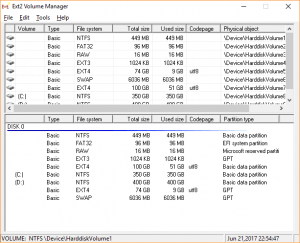
As a result, using volumes may be the best alternative for holding state between container runs.

External volume manager windows#
But, if you are using Docker Desktop on Windows or MacOS bind, mounts have significant performance issues. This is called a bind mount and is commonly used by developers. Navigate to and you should see “Hello from Host”. target/index.html docker run -it -rm -name nginx -p 8080:80 -v " $( pwd ) "/target:/usr/share/nginx/html nginx target onto the /usr/share/nginx/html directory container or an nginx container to visualize your html files.Įcho "Hello from Host" >. If you are using Docker for development, you must be familiar with the -v or -volume flag that lets you mount your local files into the container. When a container is started, Docker loads the read-only image layer, adds a read-write layer on top of the image stack, and mounts volumes onto the container filesystem. The purpose of using Docker volumes is to persist data outside the container so it can be backed up or shared.ĭocker volumes are dependent on Docker’s file system and are the preferred method of persisting data for Docker containers and services. In this guide, you’ll learn how volumes work with Docker, what they do, and what the best practices are for keeping them secure and effective. While it may be tempting to rely on the host file system, a better solution is to work with persistent data in a container, namely Docker volumes.Ī Docker volume is an independent file system entirely managed by Docker and exists as a normal file or directory on the host, where data is persisted. However, containers often need to use data beyond their container or share data between containers. The Docker interface is simple and users can easily create and implement applications into their containers or carry out version management, copy, share, and modify, just like managing ordinary code. You don’t have to be concerned about setting up your environment because running an image recreates everything for you and is isolated from your operating system and other running containers. When you run it, you recreate the container’s state. It allows you to deploy your application as a lightweight process set rather than a complete virtual machine.ĭocker images are like a snapshot of a container’s file system and contain both your application and its dependencies.
External volume manager software#
If you’re interested in a simple and containerized approach to building software then check us out.ĭocker is a common containerization solution that offers a user-friendly interface. This article is about container volume management. We make building software simpler and therefore faster.

We recommend including the spanned volume to your regular backups, because if one of the drives in the volume fails, the entire volume will be destroyed.We’re Earthly. The disks should also be labeled in purple (Disk 1 and Disk 3 in our example). You should see the new volume listed at the top. Step 5: Once you complete the wizard, check the Windows disk management tool for the volume you just created. Step 4: Complete the rest of the wizard, which involves selecting a drive letter and formatting the new volume. Step 3: When the New Spanned Volume Wizard appears, click Next, then add the disk(s) you want to combine, to the disk you already selected. Step 2: Right-click on one of the drives to be combined, then select New Spanned Volume. In our example, we're going to combine Disk 1 (298.09GB) and Disk 3 (186.31GB). Make sure that the disks you want to combine, are unformatted and don't contain any partitions. This will launch the Windows disk management tool. Step 1: Go to Start, then type "diskmgmt.msc" in the search box. The Windows XP/Vista/7 feature is called spanning, and it can extend the usefulness of older, smaller hard disks.

Can't afford a 1TB drive, but you've got two 500GB drives just lying around? Windows can combine them.


 0 kommentar(er)
0 kommentar(er)
